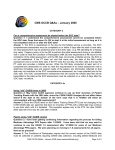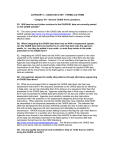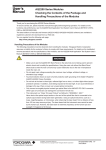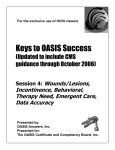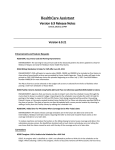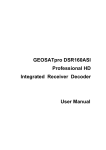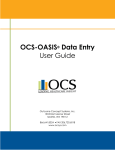Download CMS OCCB 4th Qtr 2008 QAs_01_20_09
Transcript
DEPARTMENT OF HEALTH & HUMAN SERVICES Survey and Certification Group 7500 Security Boulevard Baltimore, Maryland 21244-1850 Survey and Certification Group January 20, 2009 Linda Krulish, PT, MHS, COS-C President OASIS Certificate and Competency Board, Inc 850 Kaliste Saloom Road, Suite 123 Lafayette, LA 70508 Dear Ms. Krulish: Thank you for your letter of January 5, 2009 in which you requested review of a number of questions and scenarios related to data collection and accurate scoring of Outcome and Assessment Information Set (OASIS) items. The accompanying questions and answers have been reviewed by CMS staff, selected content experts and contractors, and consensus on the responses has been achieved. As deemed valuable for providers, OASIS Education Coordinators and others, CMS will consider incorporating these questions and answers into future updates to the CMS Q&As posted at https://www.qtso.com/hhadownload.html, and/or in future revisions to the OASIS User Manual, Chapter 8, Item-by-item Tips. In the meantime, you are free and encouraged to distribute these responses through educational offerings sponsored by the OASIS Certificate and Competency Board, Inc. (OCCB) or general posting for access by all interested parties. Thank you for your interest in and support for enhancing OASIS accuracy. Sincerely, Patricia M. Sevast, BSN, RN Nurse Consultant Survey and Certification Group Centers for Medicare & Medicaid Services Cc: Debora A Terkay, RN, MS Office of Clinical Standards and Quality CMS OCCB Q&As – January 2009 (www.oasiscertificate.org) Page 1 of 9 CMS OCCB Q&As – January 2009 CATEGORY 2 – Comprehensive Assessment Non-clinician making the first visit to the patient Question 1: Can our agency send out a non-clinical person to be the initial contact with a patient, to explain forms, collect signed consent forms, HIPAA forms, patient rights forms, etc, and collect demographic information to pass on to the assessing clinician who will visit the patient at some point after this "intake visit" to conduct the initial assessment visit, and the comprehensive assessment? Does this practice violate the need to have an RN, PT, OT or SLP conduct the initial assessment visit? Would the answer change if the person going to the home first to do the "intake visit" was an LPN? Answer 1: The Comprehensive Assessment of Patients Condition of Participation (484.55) requires that the initial assessment visit must be completed by an RN, if nursing orders exist at the SOC and by an appropriate, qualified therapist if no nursing orders exist. It would not meet the requirements of the Condition for an individual who is not qualified to perform assessments to enter the home before the skilled clinician who will be performing the initial assessment. This requirement is designed to ensure that the patient's immediate needs can be assessed and met. If an agency allowed a non-clinical person to enter the home to collect demographic information and explain rights and responsibilities, etc, it is possible that a potentially life threatening condition may not be assessed and treated. LPNs are not qualified to complete assessments so therefore it would not be compliant with the Condition to allow an LPN to conduct the initial assessment. The agency may have a non-clinical person (or LPN, etc.) contact the patient by phone prior to the initial assessment visit to gather or impart some of the information related to patient rights and services, but the actual first visit to the home constitutes the initial assessment visit and must follow conditions outlined in the CoPs. Completing/Correcting OASIS after assessing clinician no longer available Question 2: We are seeking guidance related to the following scenarios: A) A qualified clinician completes the visit for the initial visit and comprehensive assessment, however before finishing the documentation of the corresponding OASIS, the clinician quits. The other pieces of the comprehensive assessment documentation are complete. What are the appropriate steps to complete the OASIS? B) The qualified clinician completes an OASIS and then quits. During review of the documentation, a clinical supervisor notes a discrepancy between an OASIS response and other clinical documentation. What are the appropriate steps to correct the OASIS assessment? C) Are there any other circumstances when it is appropriate for the director or supervisor to make a correction to an OASIS answer in lieu of the assessing clinician? Answer 2: A) In your scenario you state that a qualified clinician completed the initial visit and comprehensive assessment but did not complete the OASIS data items. For patients that require OASIS data collection (skilled Medicare, skilled Medicaid and others as directed by agency policy) the OASIS data items are considered part of the comprehensive assessment. They are not to be separated, but are integrated into the comprehensive assessment in a clinically meaningful manner. If following this requirement, as detailed in the OASIS Implementation manual, Chapter 4 and CMS OASIS OCCB Q&As 7/08 Q2, it is not understood how a clinician could have compliantly completed the comprehensive assessment without completing the OASIS data items. If the comprehensive assessment for a patient requiring OASIS data collection was completed in a noncompliant manner and the OASIS data items were not completed, the agency should send another qualified clinician out during the allowed timeframe for completing the assessment, within 5 days after the CMS OCCB Q&As – January 2009 (www.oasiscertificate.org) Page 2 of 9 Start of Care (SOC) date, to start and complete an entire comprehensive assessment, not just the OASIS items. It would be required that another qualified clinician complete the entire assessment because only one person can complete an assessment, it is not a collaborative effort between field staff or field staff and supervisors. When a clinician signs the assessment, it is an attestation that everything contained in the assessment is truthful and accurate, based on that clinician’s assessment. Information in the medical record cannot be "made up" or "created" in an effort to be compliant with the Comprehensive Assessment of Patient Condition of Participation’s (484.55) required timeframes. Careful documentation should be included in the medical record to explain the circumstances that led to the non-compliance. B & C) The comprehensive assessment, including the OASIS, can only be completed by one person. It is a legal document and when signed by a clinician, the signature is an attestation that all contained in the document is truthful and accurate. If an error is discovered upon review by a supervisor or other auditing staff and it can be validated that it is a true error and not just a discrepancy (a difference between two data items without knowledge of which data item is correct), that error should be corrected following the agency's correction policy and established professional medical record documentation standards. The following references from the OASIS Implementation Manual may be useful in developing or refining your agency’s correction policy. Additionally, guidance found in the State Operations Manual Appendix B: Guidance to Surveyors: Home Health Agencies CoP 484.48 Clinical Record Interpretive Guidelines offers additional guidance. Correction Policy References: Chapter 2 OASIS Implementation Manual The agency must correct any information that does not pass the CMS-specified edits (i.e., is missing, incorrect, or inconsistent). Staff entering data may need to contact the qualified clinician who assessed the patient for assistance in making those corrections. The clinician's recall of the patient assessment and clinical notes which document the assessment are better at a point in time closer to the assessment activity than if the edits and corrections are delayed. Chapter 9 of the OASIS Implementation Manual, page 9.7, states: Correction of clinical documentation errors is more time consuming because the documentation must be returned to the clinician with an explanation of the error. The clinician must correct the error promptly and return the record to the data entry staff person. The correction is then entered and the record checked again for errors. In some instances, the correction of one error can cause another error to surface, and the process must be repeated. The agency will benefit from designing a systematic process for correcting clinical documentation errors which functions efficiently despite clinicians' absences or their inability to return to the office. Revising such processes may indicate the need to review and revise the agency policy for correcting clinical records. This process should clearly define each step, identify responsible persons at each step, and estimate the time allowed for each step. If copies of documentation are submitted for data entry, the procedure will need to include steps to ensure the correction is made in the official agency clinical record as well as in the data submitted to the State agency. As with other process changes, once the process is finalized, it must be rigorously enforced. The agency can monitor its own compliance with the 30-day submission requirement by including this component in the tracking system. The correction policy has not changed and corrections can be made following guidance found on the CMS website. Go to the Survey and Certification page at: http://www.cms.hhs.gov/SurveyCertificationGenInfo/PMSR/list.asp. In the left column click on Policies and Memos to State and Regions, scroll to: New Correction Policy for HHAs, Memo # 01-12, posted 04/20/01. Chapter 9 OASIS Implementation Manual 4. Why is it more time consuming to correct clinical documentation errors than data entry errors? Most agencies require clinical documentation errors to be corrected by the clinician because the patient's record is a legal document that the clinician has signed. Therefore, the clinician must be made aware of the error (either by a person doing the upfront review or by the one running the edit check process) and must make arrangements to correct the error in the clinical record, which CMS OCCB Q&As – January 2009 (www.oasiscertificate.org) Page 3 of 9 then must be corrected in the data entered for reporting to the State. Because it is possible for the correction of one error to generate other errors, the edit check procedure must be run again after data are corrected. If additional errors are discovered, the process must be repeated. Chapter 10 OASIS Implementation Manual 10. Where can I find information on correcting errors in my agency's production data submissions? Information on correcting, inactivating, or deleting assessments from the state database (once the data have been transmitted) is found in CMS' Survey and Certification Memorandum 01-12, published on April 20, 2001, found at http://www.cms.hhs.gov/SurveyCertificationGenInfo; click on "Policy & Memos to States and Regions." This same memo is located on the QTSO web site at http://www.qtso.com/hhadownload; scroll down to the HHA Correction Policy. Chapter 12 OASIS Implementation Manual If differences are found that cannot be explained by other documentation in the clinical record, the care provider who completed the OASIS should be contacted to determine if the discrepancies were real (e.g., the patient did change significantly between the SOC visit and a visit the next day) or if an error was made when recording OASIS data. If data quality problems exist, the problems can be corrected. If clinical documentation must be amended, this should be done according to agency policy. Any corrections to OASIS data in the clinical record must also be reflected in the OASIS database maintained by the agency, and if data submission has already occurred, a correction must be submitted to the State. Completing the DC comprehensive assessment when the assessing clinician is no longer available Question 3: In reviewing CMS OCCB 10/2008 Q1, the response states that “there may be situations when a Discharge Assessment cannot be completed if no one clinician has all the information needed to complete it”, in which cases the circumstances related to the non-compliance should be documented. Our documentation software program does not allow us to begin a new SOC for a patient, unless they have had a discharge assessment from a previous episode. Therefore, our internal documentation of the discharge and explanation of circumstances is not sufficient to allow us to readmit the patient at a later date. Please advise. Answer 3: In situations where it is discovered than no one completed a Discharge assessment and there is no one person at the agency who has all the information needed to complete the assessment, it may not be possible to produce a Discharge assessment. This, of course means you are non-compliant with the Condition of Participation 484.55, Comprehensive Assessment of Patients. Some computer software systems may require an agency to enter OASIS data at discharge in order for the system to function as designed. If the agency chooses, they may go back to the SOC assessment and utilize that data to complete the assessment as a clinician qualified to perform a comprehensive assessment must have completed it. Carefully document in the clinical record why this is being done. (See CMS OASIS Q&As Category 2, Question 37 for more detail). Again, this will represent noncompliance with the CoP 484.55 because an assessment was not performed at discharge, but will allow you to submit a Discharge Assessment. Note this will have a negative impact on your outcomes, as there would not be any improvement in any of the outcome measures. If this option is not selected, the agency should document in the chart why a Discharge assessment was not completed and perform an internal agency discharge to remove the patient from the billing system. The patient will remain on the OASIS Patient Management Roster for 6 months and then be removed by the state. CMS OCCB Q&As – January 2009 (www.oasiscertificate.org) Page 4 of 9 Completing RFA 6/7, Transfers and RFA 8, Death at Home Question 4: Who can complete the OASIS data collection that occurs at the Transfer and Death at Home time points? Can someone in the office who has never seen the patient complete them? Does it have to be an RN, PT, OT or SLP? Answer 4: Since the Transfer and Death at Home OASIS time points require data collection and not actual patient assessment findings, any RN, PT, OT or SLP may collect the data, as directed by agency policy. Chapter 8 of the OASIS Implementation Manual, under M0100, explains that a home visit is not required at these time points. As these time points are not assessments and do not require the clinician to be in the physical presence of the patient, it is not required that the clinician completing the data collection must have previously visited the patient. The information can be obtained over the telephone by any RN, PT, OT or SLP familiar with OASIS data collection practices. This guidance applies only to the Transfer and Death time points, as a visit is required to complete the comprehensive assessments and OASIS data collection at the Start of Care, Resumption of Care, Recertification, Other Follow-up and Discharge. Providing Treatment Visits prior to ROC Assessment Question 5: My patient was released from hospital. She needs an injection that evening and the case manager is unavailable and is going to resume care the following day. Can the on call nurse visit and give the injection before the resumption of care assessment is done? Is there a time frame in which care (by an LPN or others) can be provided prior to the completion of the ROC assessment? Answer 5: There are no federal regulatory requirements that prevent an LPN from making the first visit to the patient when resuming care after an inpatient facility stay, but there must be physician orders for the services/treatments provided during that visit. It is not required that the ROC comprehensive assessment be completed on the first visit following the patient's return home. OASIS guidance states that the Resumption of Care comprehensive assessment must be completed within 2 calendar days after the patient's return from the inpatient facility. The clinician that completes the ROC comprehensive assessment must be an RN, PT, OT or SLP. Drug Regimen Review in Therapy Only Cases Question 6: For therapy only cases where the therapist is completing the comprehensive assessment, is it acceptable practice to have an office based RN complete the medication review by reviewing the med profile completed by the therapist during the home visit, and making telephone contact with the patient/caregiver for any necessary discussion of side effects, interactions, duplicate or compliance issues? My understanding is that one clinician must complete the comprehensive assessment. Is this practice out of compliance with that rule? Answer 6: You are correct, only one clinician can complete a comprehensive assessment. A CMS OASIS Category 2 Q&A (posted below) explains that your agency may develop policies regarding how to handle the drug regimen review in therapy only cases. In therapy only cases, it is acceptable for an RN in the office to perform additional portions of the medication regimen review after the therapist collects the information regarding the patient's medication regimen as part of the comprehensive assessment. This would not be viewed as a violation of the one clinician rule. If areas of concern are identified, the agency must notify the physician and obtain orders for any nursing intervention to further assess and resolve issues and educate the patient regarding medication changes and management. Note that the therapist’s face-to-face assessment may need to include more than just creating a list of medications in order to allow the additional review to be completed by an in-office RN. For instance, in identifying potential ineffective drug therapy or non-compliance, the therapist may need to assess and report physical signs and symptoms (such as depressive symptoms, edematous feet, rash, pain), or may need to report observations (such as pills remaining in med planner from previous days), or subjective comments related to the patient’s compliance with medications. Q32. Does the medication list need to be reviewed by an RN if the patient is only receiving therapy services? A32. The standard for the drug regimen review is not new; it was included in the previous conditions of participation (CoP) under the plan of care requirements. The comprehensive assessment must include a review of all medications the patient is using in order to identify any CMS OCCB Q&As – January 2009 (www.oasiscertificate.org) Page 5 of 9 potential adverse effects and drug reactions, including ineffective drug therapy, significant side effects and drug interactions, duplicate drug therapy, and noncompliance with drug therapy. The scope of the drug regimen review has thus been narrowed from the previous CoP. Each agency must determine the capabilities of current staff members to perform comprehensive assessments, taking into account professional standards or practice acts specific to your State. No specific discipline is identified as exclusively able to perform this assessment. CATEGORY 4b – Item-specific Questions M0090 Question 7: I was reviewing CMS OCCB 4/08 Q#4 and noted that the response states: "if the original assessing clinician gathers additional information during the SOC 5 day assessment time frame", M0090 would need to reflect that more recent date. Our practice is to hold the OASIS SOC until all the therapy disciplines have submitted the add-on orders, complete with their frequencies. Then the OASIS document is submitted with the totaled number. This should be our best estimate of the actual number of visits planned for the patient by therapy. My question is: In our situation, would "original assessing clinician" extend to the record review department? Would they need to change the M0090 answer once the totaled number of visits is added and put in M0826? Answer 7: Only one clinician can complete the comprehensive assessment including the OASIS. If the clinician responsible for completing the OASIS assessment gathers new information during the 5 day assessment time period, s/he may change the response to that item and change the M0090 date to reflect the date the latest new information was gathered. This would apply to M0826. If the OASIS is completed by the assessing clinician and then, through an internal review process in the office, it is discovered that the OASIS data contains one or more errors, the identified data item(s) could be corrected by the qualified clinician responsible for performing the review following your agency's correction policy and in such cases of error correction, M0090 would not be changed. M0290 Question 8: In answering M0290 High Risk Factors, what does CMS consider "drug dependency" (response 4)? A consultant instructed our agency to interpret it to mean any drugs that the patient is dependent on. The consultant then commented that response 4 should be marked for most patients. The specific example in the reviewed chart was a patient who was very dependent on all of their respiratory drugs. We previously interpreted this to mean dependency on illegal drugs. Please clarify. Answer 8: Chapter 8 of the OASIS Implementation Manual defines the intent of M0290, "Identifies specific factors that may exert a high impact on the patient's health status and ability to recover from this illness." The intent of the item is not to address those medications/drugs that the individual takes/consumes/administers to achieve a therapeutic effect, such as insulin, blood pressure medication, cardiac arrhythmia medication, respiratory medication, etc. It is also necessary to acknowledge that situations can occur where the once-therapeutic use of medication becomes a true dependency situation, e.g. pain medications. This is an example where "informed professional decision-making" (as noted in the Response-specific Instructions on page 8.51 of the manual) must be applied to a specific patient situation. M0464 Question 9: I recently attended a conference on wounds. It was stated in the conference that stage II pressure ulcers do not granulate, therefore the best match per the WOCN guidelines is "not healing". I am hesitant to instruct my staff on this change, since there is no such guidance in the literature other than all stage I pressure ulcers are not healing. Is there any advice you can give me? CMS OCCB Q&As – January 2009 (www.oasiscertificate.org) Page 6 of 9 Answer 9: While it is true that Stage II ulcers do not heal by granulating, the exposed dermis is reepithelialized during the healing process. Automatic selection of response “3 –Not healing” is not a correct practice. In determining the healing status of a Stage II pressure ulcer, the current WOCN OASIS guidelines should be consulted. M0482 Question 10: Would an oral surgical wound (incision/stitches) be counted as a surgical wound? Answer 10: Surgical incisions in the oral mucosa, like incisions resulting from cataract or vaginal surgeries, would not be considered a lesion or surgical wound for M0440 or M0482. M0440 captures skin lesions or an open wound to the integumentary system, and only certain specified types of wounds are considered surgical wounds for M0482. Mucosal membranes are not to be considered as part of the integumentary system for the purposes of OASIS data collection. M0484 Question 11: I have a patient with a surgical incision where staples have been removed, but the incision is not yet a scar - not totally epithelialized. There are two openings along the incision line where the edges are not approximated. I know those two openings are counted as separate wounds, but do you also count the original incision – i.e. are there 3 wounds or just 2? Answer 11: In your description, you have a surgical wound that is healing at varying rates, but you do not have complete epithelialization in any part of the wound. Therefore, you still have just one surgical wound. If there had been a section of the wound that was considered healed (4 weeks post complete epithelialization) and there were two openings separated by the healed area, you would have two surgical wounds. M0700 Question 12: A patient is able to ambulate independently with a walker, but the patient chooses to not use the walker, therefore not being safe. When selecting a response for M0700 Ambulation/Locomotion, should I select Response #1, that the patient is able to ambulate safely with the walker or should I select Response #2 that the patient is only safe when walking with another person at all times, because he chooses to not use his walker? Answer 12: The OASIS items should report the patient’s physical and cognitive ability, not their actual performance, compliance or willingness to perform an activity. You state the patient is able to ambulate independently with a walker, so we will assume you meant that the patient is able to ambulate without human assistance safely with the walker. This would be scored a “1” for M0700 Ambulation/Locomotion. You state the patient’s actual performance is that he is unsafe ambulating because he chooses not to use his walker. This patient would still be scored a “1” unless, as you pointed out, the clinician identified some other physical, cognitive or environmental barrier that prevents the patient from utilizing his walker to assist with ambulation, e.g. fear, memory impairment, undisclosed pain associated with walker use, or other emotional, behavioral or physical impairments. If there was a barrier preventing the patient from safely utilizing the walker during ambulation, the clinician would need to determine if the patient needed someone to assist at all times in order to ambulate safely and if so, the appropriate score for M0700 would be a “2”. If the patient only needed assistance intermittently, the correct response would be a “1”. M0780, M0790, and M0800 Question 13: It is our understanding that if the nurse is ordered to administer a medication, the patient is considered dependent for that (oral, inhalant/mist or injectable) medication. At SOC, if a patient has been in the hospital where all medications were administered by hospital nursing staff, would this make the patient dependent because the majority of medications over the past 24 hours were administered by the acute care nurse at the hospital? Answer 13: In the case of an admission to home care following a discharge from an inpatient facility, M0780, M0790 and M0800 should be scored based on the orders relevant to medications that will be taken/administered in the home and will not include a reporting of medications that were administered CMS OCCB Q&As – January 2009 (www.oasiscertificate.org) Page 7 of 9 while the patient was an inpatient. Restrictions imposed during a recent hospitalization should not impact the reporting of the patient's current status. If the patient had been discharged from an inpatient facility on the day of the assessment (24 hours immediately prior to the clinician's visit and the time spent in the home), the clinician would gather information by report regarding the patient's cognitive and physical status prior to the visit and assess the patient's status during the visit and make a determination regarding the patient's ability to manage the medications ordered to be administered in the home. At the SOC, the clinician has up to five days after the SOC date to complete the comprehensive assessment, including the patient’s ability to manage medications. If the patient's ability to manage the home medications varied on the day of the assessment, the clinician would report what was true greater than 50% of the time. If the patient's ability varied between the various prescribed and OTC medications, the clinician should consider the total number of medications and the total daily doses in determining what is true most of the time. M0800 Question 14: How would you respond to M0800 if a patient is able to self-inject a pre-filled injectable medication such as Lovenox? Obviously the patient cannot be observed "preparing" a pre-filled injectable. Which response best fits this scenario? Answer 14: When the medication is supplied by the manufacturer/pharmacy in a pre-filled syringe, the clinician will not include assessment of the patient's ability to fill the syringe. The included tasks in this situation would be handling the syringe using aseptic and safe technique, selecting the correct location in which to inject the medication and injecting it using proper technique and disposing of the needle and syringe appropriately, and the patient could be a "0", "1", or "2". M0810, M0820 Question 15: I was wondering on how to handle M0810 & M0820 regarding equipment when we are only performing a flush. I understand from the CMS guidance that a flush is considered an infusion for M0250, as long as it is provided in the home. Would I then consider the syringe as the equipment for M0810 and M0820? Also, we recently had a patient with a fully implanted subcutaneous infusion device. There was no external equipment to assess. Since this was an ongoing infusion, the patient did receive this in the home, and therefore we answered response "1" in M0250- but since there is no equipment to even assess, how do we answer M0810/820? Answer 15: M0810/820 assesses the patient/caregiver's ability to set up, monitor and change the equipment and supplies required for in-home IV/infusion therapy (including flushing), oxygen, and enteral/parenteral nutrition reliably and safely, and the amount of assistance required from another person. If the only equipment utilized to administer an infusion/flush is a needle and syringe, the clinician will assess the patient's ability to select the appropriate syringe and needle, fill the needle with the appropriate solution utilizing safe and appropriate technique, handle the needle and syringe appropriately as they access the port, monitor the administration of the infusion/flush to ensure it is appropriate and safe, change the needles and syringes safely and appropriately and dispose of the needle and syringe safely and appropriately. In a situation where the infusion is administered via an implanted pump and there is no equipment accessible to the patient or which requires patient management in the home, the correct response for M0810/820 would be "NA-No equipment of this type used in care". Note that per Item-by-Item Tip Assessment Strategies, if the patient is using more than one type of equipment; consider the equipment for which the most assistance is needed. CMS OCCB Q&As – January 2009 (www.oasiscertificate.org) Page 8 of 9 ATTACHMENT D – Selection & Assignment of OASIS Diagnosis Question 16: Q&A #16 released in January 2008 states that “At this time there is not OASIS guidance suggesting that you must rank diagnoses by their severity rating”. The December 2008 release of Attachment D states: “Ensure that secondary diagnoses assigned to the OASIS are listed in the order to best reflect the seriousness of the patient’s condition and to justify the disciplines and services provided.” Please clarify. Answer 16: Per Attachment D, secondary diagnoses reported in M0240 should be listed in order to best reflect the seriousness of the patient's condition and to justify the disciplines and services provided. Severity rating should not be considered in the sequencing of secondary diagnosis in M0240. Please submit questions related to Attachment D: Selection & Assign ment of OASIS Diagnosis to [email protected] CMS OCCB Q&As – January 2009 (www.oasiscertificate.org) Page 9 of 9









